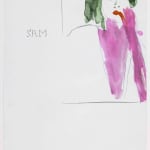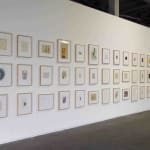
Exhibition view, Blow Job, 30 March — 27 July 2008, Kunsthal Extra City
Peter Friedl
Friedl's multifaceted works and projects-consistently heterogeneous in terms of medium, style, and meaning-have been repeatedly acknowledged as models: as exemplary articulations and solutions of aesthetic problems involving political and historical awareness. In pursuit of new narrative models, they explore the conditions and limits of representation, employing conceptual strategies such as permanent displacement, decontextualization, and the reinterpretation of genres left over from the history of modernism.
Friedl uses the authenticating medium of the handmade drawing-in its broadest sense-as a lyrical voice, which documents and comments on both personal and socio-political histories, always on the fringes of potential counter imagery. His artistic method is characterized by affirmation, reflection, and mimicry. Scribbled words refer to the fact that writing is simply another form of drawing. The motifs in his drawings encompass a wide range, from autobiographical, rather private notes, the "political unconscious" of the early drawings, through to numerous historical and phantasmagorical portraits in recent years, including, among others, those of the legendary Algerian militant Djamila Bouhired, Chinese feminist heroine Qiu Jin (1875-1907), Liberian war criminal Joshua Milton Blahyi (aka General Butt Naked), Polish-Jewish historian and archivist Emanuel Ringelblum (1900-44), African American business woman Madam C.J. Walker (1867-1919), 19th century feminist Flora Tristan (1803-44), Japanese anarchist, Fumiko Kaneko (1903-26), Soviet partisan Zoya Kosmodemyanskaya (1923-41), and Palestinian teenager Mohammed Abu Kdheir.
The drawing hand transforms media images into imagined, unstable, aesthetically fragile documents. In Friedl's journey through all kinds of narratives, geographies, concepts, and timelines, heterogeneous contents are matched with a vast variety of techniques. His drawings orbit the question of what an authentic subjectivity that is capable of exercising agency looks like in a post-digital era.



